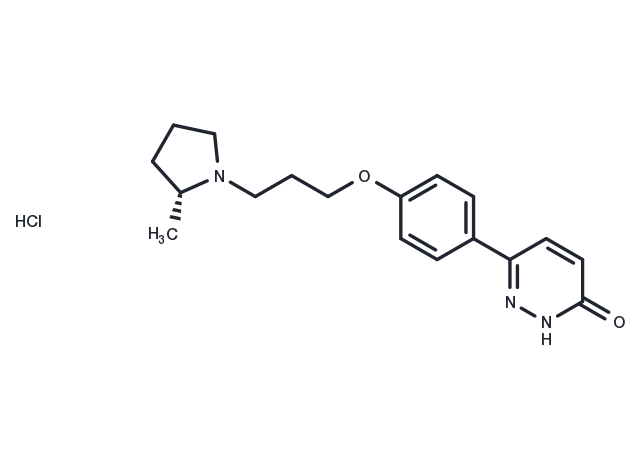Powder: -20°C for 3 years | In solvent: -80°C for 1 year


Irdabisant hydrochloride (CEP-26401) is a selective, orally active, and blood-brain barrier (BBB) penetrant histamine H3 receptor (H3R) inverse agonist/inverse agonist, demonstrating high affinity with K*i values of 7.2 nM and 2.0 nM for rat and human H3R respectively. It exhibits relatively low hERG current inhibitory activity, with an IC*50 of 13.8 μM. This compound has been shown to enhance cognition and promote wakefulness in rat social recognition models, suggesting potential applications in schizophrenia or cognitive impairment research.

| Pack Size | Availability | Price/USD | Quantity |
|---|---|---|---|
| 25 mg | 6-8 weeks | $ 1,520.00 | |
| 50 mg | 6-8 weeks | $ 1,980.00 | |
| 100 mg | 6-8 weeks | $ 2,500.00 |
| Description | Irdabisant hydrochloride (CEP-26401) is a selective, orally active, and blood-brain barrier (BBB) penetrant histamine H3 receptor (H3R) inverse agonist/inverse agonist, demonstrating high affinity with K*i values of 7.2 nM and 2.0 nM for rat and human H3R respectively. It exhibits relatively low hERG current inhibitory activity, with an IC*50 of 13.8 μM. This compound has been shown to enhance cognition and promote wakefulness in rat social recognition models, suggesting potential applications in schizophrenia or cognitive impairment research. |
| In vitro | Irdabisant (CEP-26401, compound 8a) demonstrates antagonist activities against rat and human H3 receptors with K(b, app) values of 1.0 nM and 0.4 nM, respectively, and displays inverse agonist activities with EC50 values of 2.0 nM for rat H3R and 1.1 nM for human H3R. It also exhibits moderate affinity for Muscarinic M2 and Adrenergic α1A receptors, Dopamine and Norepinephrine transporters, and phosphodiesterase PDE3, with K(i) values of 3.7 μM for M2, 9.8 μM for α1A, 11 μM for Dopamine transporters, 10 μM for Norepinephrine transporters, and an IC50 of 15 μM for PDE3. Irdabisant inhibits cytochrome P450 enzymes CYP1A2, 2C9, 2C19, 2D6, and 3A4 with IC50 values over 30 μM, suggesting minimal drug-drug interaction potential. |
| In vivo | CEP-26401, administered orally in single doses ranging from 0.01 to 0.3 mg/kg, dose-dependently suppresses RAMH-induced dipsogenia in rats, a condition characterized by excessive drinking [1]. At doses between 0.0001 and 0.1 mg/kg, given intravenously (i.v.) or orally (p.o.), it enhances performance in a rat model for short-term memory by improving social recognition [1]. Furthermore, when given orally at dosages from 3 to 30 mg/kg, CEP-26401 promotes wakefulness in rats, with significant activity observed at 30 mg/kg where treated animals remained awake for up to 90% of the time three hours post-administration [2]. Similarly, doses of 3 to 30 mg/kg administered intraperitoneally (i.p.) increase prepulse inhibition (PPI) in DBA/2NCrl mice, suggesting antipsychotic-like properties [2]. Pharmacokinetic analyses reveal that CEP-26401, at 1 mg/kg i.v. and 3 mg/kg p.o., is rapidly absorbed with high oral bioavailability in rats and monkeys. It exhibits a moderate clearance rate in monkeys and dogs in comparison to rats. The compound's pharmacokinetic profile includes a half-life of 2.6 to 5.4 hours, volume of distribution, and clearance rates across different species, alongside significant brain to plasma ratio, indicative of its effective penetration into the brain [1]. |
| Molecular Weight | 349.86 |
| Formula | C18H24ClN3O2 |
| CAS No. | 1005398-61-7 |
Powder: -20°C for 3 years | In solvent: -80°C for 1 year
You can also refer to dose conversion for different animals. More
bottom
Please see Inhibitor Handling Instructions for more frequently ask questions. Topics include: how to prepare stock solutions, how to store products, and cautions on cell-based assays & animal experiments, etc.
Irdabisant hydrochloride 1005398-61-7 inhibitor inhibit
